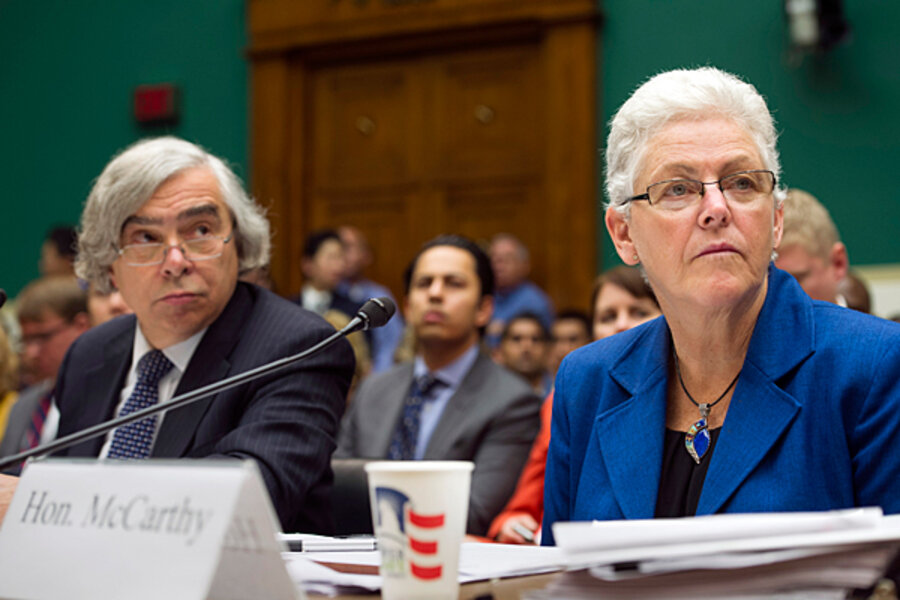Obama proposes cuts in power plant C02 emissions to tackle climate change
Loading...
The Obama administration proposed limits on carbon dioxide emissions from new US power plants Friday, taking a big step toward fulfilling a long-sought goal of fighting climate change by reducing greenhouse gas emissions.
Hailed as the first-ever nationwide limit on climate-warming pollution for power plants, the proposal would require that newly built coal-fired power plants capture and store underground about 20 to 40 percent of the carbon they emit. Critics blasted the plan, saying it would effectively “ban” coal power plants and harm the utility industry and the economy.
While coal and electric utility industry officials and their supporters in Congress charge the president with fighting a “war on coal” that will cost coal states jobs and raise electric rates, Environmental Protection Agency Administrator Gina McCarthy defended the proposed rules as affordable and reasonable.
While the EPA has, under the Clean Air Act put federal limits on toxic emissions of arsenic, mercury, and lead pollution that power plants emit – as well as on pollutants like sulfur dioxide and nitrogen oxides – there are currently no such limits on the carbon emissions from new or existing power plants. The proposed CAA rules will now undergo a 60-day public comment period, minor adjustments, and likely legal challenges as well, before being finalized next fall.
“By taking common-sense action to limit carbon pollution from new power plants, we can slow the effects of climate change and fulfill our obligation to ensure a safe and healthy environment for our children,” Ms. McCarthy said in a statement. “These standards will also spark the innovation we need to build the next generation of power plants, helping grow a more sustainable clean-energy economy.”
Power plants today are the largest concentrated source of emissions in the United States, together accounting for more than one-third of all domestic greenhouse gas emissions. The typical coal-fired power plant emits around 3.5 million tons of CO2 to the atmosphere annually, with the US fleet venting about 2.3 billion tons of heat-trapping carbon dioxide gas into the atmosphere each year.
In justifying its action, the EPA spoke of the health benefits and reduced property damage from reining in global warming over the long term, citing National Climate Data Center findings of 12 climate disasters in 2012, each causing more than a billion dollars of damage, a year-long drought, crop failures in 22 states, western wildfires that burned 9.2 million acres, as well as Hurricane Sandy. While climate change is “not the sole cause of such events” it is “a contributing factor,” the agency noted.
End 'limitless release of carbon pollution'
President Obama said the new EPA rules were in line with his mandate to address the climate change problem by reducing greenhouse gas emissions, noted in his State of the Union speech – and in a major policy speech in June.
“Today, we build on that progress by proposing common-sense standards that will begin to put an end to the limitless release of carbon pollution from our power plants, creating cleaner air and a healthier environment for our children and for future generations,” Mr. Obama said in a statement.
The move, he said, would build on existing trends in states and cities already requiring cleaner energy sources – including power companies shifting to cleaner technologies to generate electricity. Nearly a dozen states have already implemented or are implementing their own market-based programs to reduce carbon pollution, the EPA reported, and 25 states have set energy efficiency targets with 35 having set renewable energy targets.
Today, the two dominant sources of electricity are coal-fired power plants and natural gas-fired turbine plants. Under the new EPA proposal, newly built large natural gas-fired turbines would be required to emit no more than 1,000 pounds of CO2 per megawatt-hour, while new but smaller natural gas-fired turbines would need to meet a limit of 1,100 pounds of CO2 per megawatt-hour.
A typical advanced coal plant today emits about 1,800 pounds of carbon dioxide per hour compared with natural gas plants that emit around 800 pounds on average – less than the proposed new standards.
But a new coal-fired power plant would have to meet a limit of 1,100 pounds of CO2 per megawatt-hour. The new rules include an option to meet an average emissions standard over multiple years, a phase-in period intended to give power plant operators added flexibility meeting the requirement.
The new regulations are a bit less stringent for coal plants than the administration’s first proposal in April 2012, a shift that reflects some 2.5 million comments that flooded in following that proposal. A key result: the EPA dropped its April plan for a single standard and instead unveiled Friday’s separate standards for coal and for natural gas power plants – and the phase-in option.
But new coal plants would still likely need to use in their construction some type of carbon capture and sequestration (CCS) system to capture CO2 gas before it goes out the smokestack – and instead pump it deep into either underground salt-water aquifers – or alternatively inject it deep into older oil fields to squeeze more oil out of them.
EPA: Carbon capture technology 'feasible'
Industry officials and some lawmakers say the new CCS technology is unproven and unaffordable. But EPA officials, citing several demonstration projects – and a pair of coal power plants now deploying CCS, one in Canada the other in Kemper, Miss. – say the CCS technology works.
"CCS technology is feasible; it is available," McCarthy told lawmakers at a House Energy and Commerce subcommittee hearing Wednesday. "Frankly, the challenge is that we need to provide certainty for how we construct a coal facility in the future that will allow investment in that technology."
The EPA action does appear to be following, rather than leading a trend. In the first half of last year, for example, 165 new power generators were added in 33 states, but among the 10 states with the bulk of new generating capacity, "most of the new capacity uses natural gas or renewable energy," the Energy Department's Energy Information Administration (EIA) reported.
That trend is expected to continue, with natural gas-fired plants accounting for 60 percent of capacity additions between 2011 and 2035, EIA found. Coal is expected to account for seven percent. Utilities have already shuttered about 12 percent of the nation’s coal-fired generating fleet since 2010, according to M.J. Bradley & Associates, an environmental consulting firm in Concord, Mass. Most, the study said, are "small, old, and lack advanced pollution control equipment."
Over the next three years, utilities plan to build only eight new coal-fired generators compared with 91 new gas-fired generators, according to the EIA. Even so, an estimated 9 gigawatts of new coal power – about 15 average-sized plants – are expected to come online between now and 2040, the federal government reports, which is why the new rules are needed, environmentalists say.
Administration officials have steadfastly denied the claim that the White House is waging a “war on coal,” as industry groups have charged.
"No discussion of US energy security and reducing global CO2 emissions is complete without talking about coal – and the technologies that will allow us to use this resource more efficiently and with fewer greenhouse gas emissions," Energy Secretary Ernest Moniz said in remarks released by the agency during his July visit to the National Energy Technology Laboratory in Morgantown, W.Va.
Critics say standards prevent building new coal plants
In his visit, Secretary Moniz cited $6 billion in federal spending on CCS technologies. But critics aren’t buying such arguments.
“The new proposal sets a separate standard for coal-based units and requires the use of carbon capture and storage technology, which is neither adequately demonstrated nor economically feasible,” Tom Kuhn, president of the Edison Electric Institute, a trade group representing large investor-owned utilities, said in a statement. “As proposed, this rule would hinder efforts to develop cost-effective CCS – a critical technology for mitigating greenhouse gas emissions going forward – because it effectively prevents the building of new clean coal plants.”
Opposition extended beyond the utility sector.
“It is clear that the EPA is continuing to move forward with a strategy that will write off our huge, secure, affordable coal resources by essentially outlawing the construction of new coal plants,” US Chamber of Commerce Executive Vice President for Government Affairs Bruce Josten said in a statement.
Environmentalists, however, were elated. After seeing their hopes dashed for comprehensive climate legislation during Obama’s first term, Friday’s move represented what they fully expect to be an even more significant and daunting next step – to regulate emissions of the nation’s existing coal-fired power plants.
In fact, there are clear signs the administration has greenhouse gas emissions of existing power plants right in the EPA’s crosshairs. Buried in its press release, the EPA noted without fanfare that the Obama administration is moving ahead with a proposed rule to limit carbon from existing power plants by June 2014 and finalize it the year after.
“We are committed to acting on existing power plants as well,” McCarthy told reporters in a speech at the National Press Club today.








